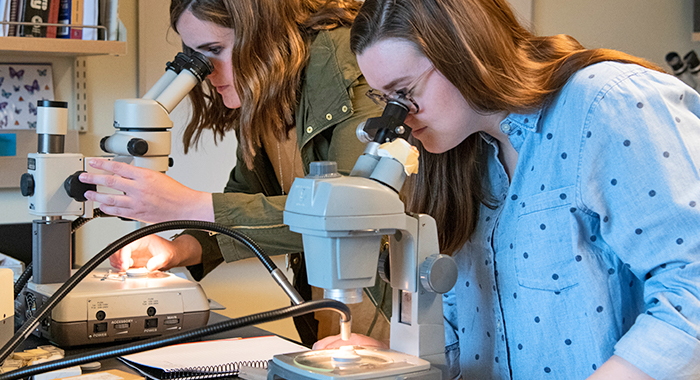Students Solve 33-Million-Year Mini Mystery
When two young scientists set out on a mission to solve a 33-million-year-old miniature mystery, the clues they followed led to a breakthrough discovery with important implications for paleontology.
Brittany Pockat ’19, an aspiring nurse, and Maddie Christel ’19, who is interested in becoming a pathology assistant, collaborated with Deb Anderson (Biology). Their task was to analyze the jaws and teeth of ancient mouse fossils discovered at a ranch in Nebraska and search for ways to distinguish species.
It would not be easy, Anderson warned them.
“I think of my work like putting a puzzle together, only you don’t have the picture on the puzzle box, and there may be pieces missing, and there may be pieces you don’t need,” says Anderson. “If that sounds fun, you can work in my lab. Anything that is exciting intellectually, you have to work at it.”
The animal in question was a pocket mouse called Heliscomys – an ancient rodent so tiny that some of its teeth were only 1 millimeter long. The students narrowed their focus to two particular species, H. hatcheri and H. ostranderi.
“Working with something so tiny was a challenge,” says Pockat. “We had a couple of teeth break off sometimes, and then we were running around like mad trying to find them!”
The “aha” moment
In the last three weeks of the project, Anderson mentioned she thought she saw something on the mandible. “We lined them all up and we were like, ‘Oh wow! That’s cool. That could be a defining characteristic,’ ” says Pockat. This, was their “aha” moment. They had discovered something nobody else had found before: a completely new way to tell two species apart.
“We discovered a ridge on the mandible and one of the cusps on the teeth was off center, and based on that we were able to identify the species,” says Christel. “There had been prior work on the upper jaws but the two species had never been distinguished based on the lower mandibles. We were able to distinguish them just based on molars.”
As Christel and Pockat prepare to begin graduate school, they are grateful for the scientific experiences provided by St. Norbert College. “We took away a lot,” says Christel. “It opened our mind to a whole other side of science. You see where two species start to branch off, and you could see how it connects to other species. It’s something we can bring to the table and say, ‘This is what we got to do and experience.’ ”
Pockat appreciated the chance to connect with a respected mentor while also connecting with the past. “What I took away was holding a piece of history, and getting to see such a small organism and how we made a difference in this piece of research with Dr. Anderson,” she says. “It was cool for us to work alongside her and see what she does outside of teaching.”
Christel adds: “She has been such a blessing to both of us. She has gone out of her way to provide us opportunities and help us seek opportunities,” she said. “I definitely think we couldn’t thank her enough for our last four years.”
July 30, 2019












